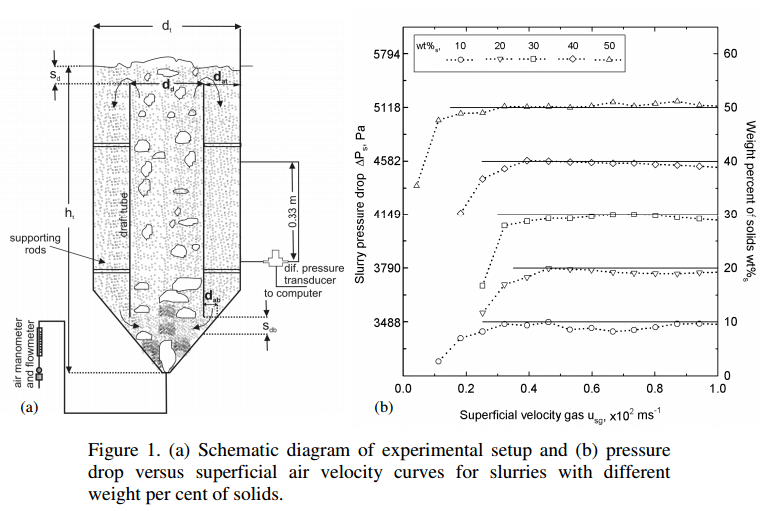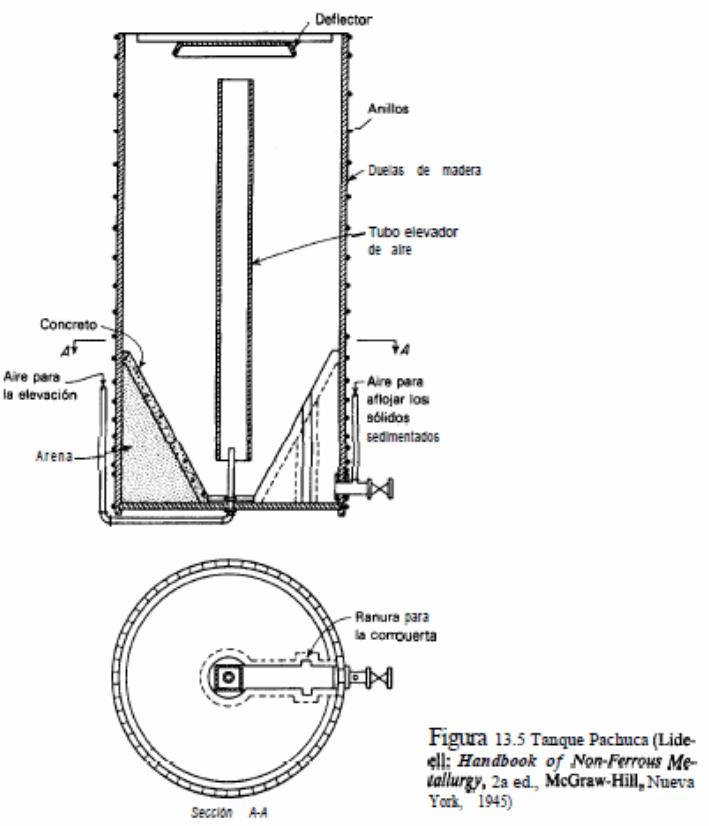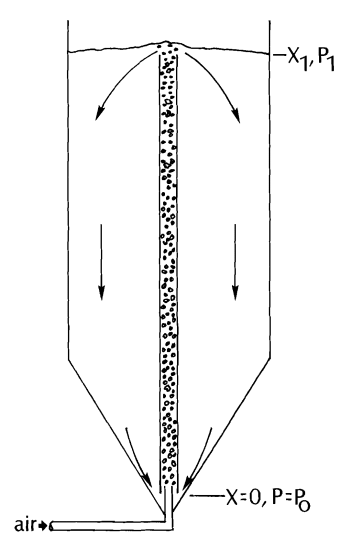
Pachuca tanks are used for a wide variety of leaching and mixing operations in the minerals industry. Previously, an equation was derived to predict the circulation in a Pachuca tank with full height draft tube risers. This analysis was subsequently verified with data from a large bore air-water flow loop used. However, the equation was based on the assumption that the solids settling velocity was small so that an homogeneous slurry was used in the modelling. An analysis is presented hereafter for the case where solids settling is significant. Settling of solids is shown to reduce the slurry superficial velocity for a particular gas superficial velocity because the slurry density in the draft tube riser is greater than the average slurry density in the annular down-comer of the tank. Only the case of Pachuca tanks with full height draft tube risers is considered. Circulation in vessels without draft tube risers or baffles is treated elsewhere.
A Pachuca, or Brown, tank consists of a large cylindrical vessel, commonly 4 to 10 m (13 to 33 ft) in diameter, and about 15 m (50 ft) high. The base of the tank is formed from a steep cone so sludge or particles settling in the tank will fall to the center (Fig. 1). To agitate slurry in the tank and discourage particle settling, air is injected at the base of the tank from the cone’s center. In some Pachuca tanks, air is allowed to rise in a free two-phase flow jet to the surface of the slurry so a natural circulation pattern is set up in the pulp. In other tanks an axially located draft tube, typically 0.5 m (20 in.) in diameter, carries a buoyant air-slurry dispersion from the bottom of the tank to the surface of the slurry. Slurry flows back through the annular space between the draft tube and tank wall. In a Pachuca tank, the tube may extend vertically only half the height of the tank, so that mixing occurs by a combination of the draft tube and free two-phase jet effects.
he first agitation was mechanical, using stirrers and centrifugal pumps to circulate the pulp through relatively low, large diameter tanks, referred to as “flak tanks.” The importance of more air was soon recognized and the Brown agitator, using an air-lift instead of a’ centrifugal pump, was introduced in 1907 at the San Francisco mill and gained rapid favor under the name of “Pachuca tank“.
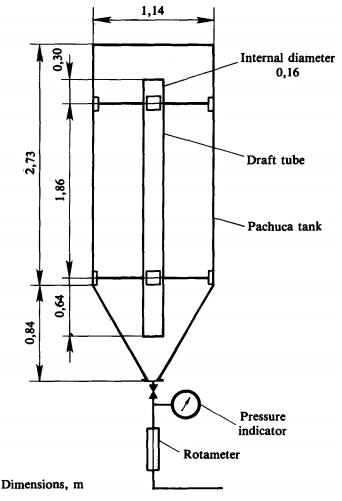
Pachuca tanks are hydrometallurgical reactors used for the leaching of nonferrous minerals. They are cylindrical vessels that normally have a conical bottom and include a central draft tube. The mineral slurry contained in the tank is agitated by air blown below the lower entrance of the draft
tube and rising through it in the form of bubbles. In these reactors the large processing capacity, tied to their considerable size (e.g., dd = 0.8 m, dt = 4.5 m and ht = 18 m in draft tube diameter, tank diameter and tank height, respectively, as cited in), has called attention for their optimization. This has led to increased interest in laboratory and modelling investigations of these tanks, as well as, on draft tube bubble column reactors. Although, both reactors have similar shape they also exhibit important differences in regard to dimensions and mode of operation, which make them quite distinguishable, i.e., Pachuca tanks have much larger diameter, smaller ht/dt ratios, use smaller superficial air velocities and process more concentrated slurries than column reactors. These differences make inadequate to use as guidelines the results obtained from one reactor in foreseeing the behavior of the other. Moreover, the results obtained from laboratory-scale Pachuca tanks have led to think that the critical velocity for complete off-bottom suspension occurs at dd/dt = 0.6, and that the industry choice of a dd/dt = 0.1 is motivated more by the smaller capital cost of a small diameter draft tube than by any suspension benefit that this ratio could have over the other.
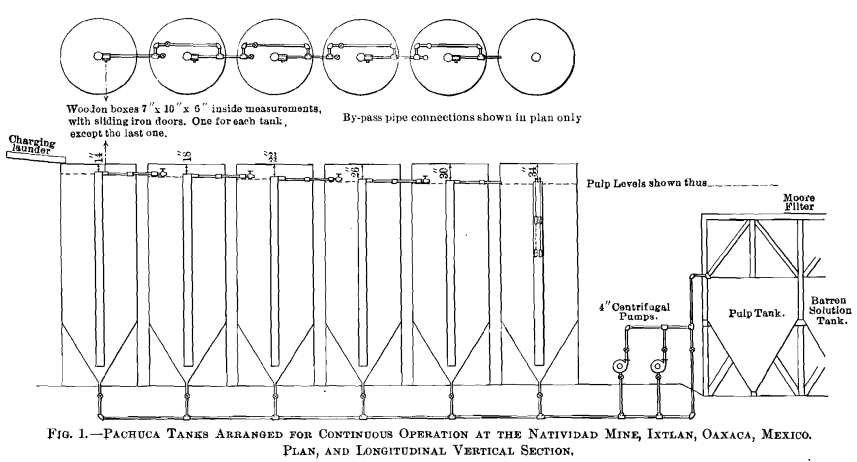
For a continuous flow of pulp from tank to tank, the outflow must be equal to the inflow in each tank, that the level may remain constant; and if the inflow is mixed thoroughly with the pulp already in agitation in the tank, as it would be in the central air-lift, then, roughly speaking, that part of the inflowing pulp which flows out of a tank in a short period of time will be to the whole inflow in that time as the quantity of inflowing pulp is to the whole charge. Thus, if a tank contain 100 tons of pulp, and 10 tons flow in during an hour, roughly, one-tenth’of the latter, or 1 ton, will flow out to the next tank in the first hour; one-tenth of the ton which flows into the second tank mill pass to the third, and so on through the series. The number of tanks in the series will, therefore, determine the power to which the fraction is raised for a short period of time. As the process is continuous, obviously these figures are not exact; but for practical purposes we may assume that with a series of tanks, the part of the pulp receiving a shorter period of agitation than the average will be balanced by the part receiving a longer period, and that in a series of six tanks having a capacity of 600 tons in all, and with 10 tons an hour passing through the system, the pulp would receive 60 hours’ agitation. The same tanks, if filled, agitated, and discharged by the intermittent system, would give only 40 hours’ agitation.
Laboratory Pachucas Tanks
As a rule these miniature Pachucas are not satisfactory as it is difficult to proportion the air to the volume of pulp so as to correspond with milling conditions. In addition to this a small amount of material especially the heavier and more mineralized particles is liable to accumulate in the dead zone at the apex of the cone and escape proper treatment, and when the contents of the tank are dumped for sampling this partially treated material may seriously affect the assay.
Pachuca Agitator
Pachuca Agitators effect agitation and oxidation by means of air pressure. The tank is circular in shape, and equipped with a 60° conical false bottom and a central air tube which is approximately 1/10 of the diameter of tank.
Compressed air is introduced into the lower end of the tube by either a rubber sleeve valve, a ball cock, or a plain pipe line extending from the top of the tank to the bottom of the tube. The lower end of this pipe line is turned up to introduce the jet of air into the lift tube.
After the tank is filled with pulp, the air valve is opened. This permits the air to enter the tube under pressure, making an upward current, and overflowing at the top while fresh pulp is taken in at the bottom. A complete circulation of the pulp is produced by this action, and it can be continued until all values have passed into solution.
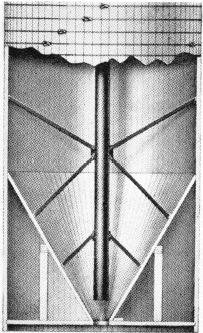 Cross-Section of Pachuca Agitator Showing Conical Bottom
Cross-Section of Pachuca Agitator Showing Conical Bottom

Effect of solids settling on Pachuca tank performance: Clark, N. N.Atkinson, C. M. Organization: Society for Mining, Metallurgy & Exploration, Pages: 4
Predicting The Circulation Rate In Pachuca Tanks With Full Height Draft Tubes: Clark, N. N. AIM & Metallurgical, and Petroleum Engineers, Pages: 7
Mathematical Modelling of Particle Suspension in Pachuca Tanks: Esperanza, Rodríguez M. The Minerals, Metals and Materials Society, Pages: 8

